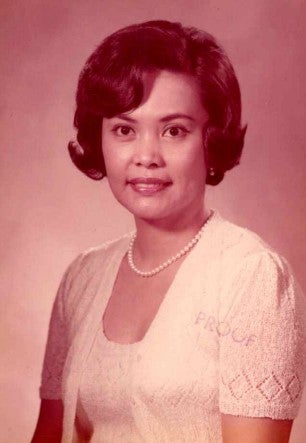History
The Hawaiʻi Police Department has been in existence since 1943. However, law enforcement on Hawaiʻi Island, in one form or another, can be traced back to about 500 A.D. From the late 1890s until 1905, officers were overseen by a sheriff, who was appointed by a police marshal on Oʻahu, who in turn was appointed by the king. After the Territorial government passed Act 39 in 1905 establishing County governments on each major Hawaiian island, the sheriff was elected to office by the voters of Hawaiʻi County. The sheriff in turn, appointed deputy sheriffs and hired officers.
Hawaiʻi Police Department Chiefs
The Hawaiʻi Police Department has had 12 Police Chiefs since the department began in 1943. Learn more about their history and accomplishments during their tenure.
The Counties Are Created in the Territory of Hawaiʻi
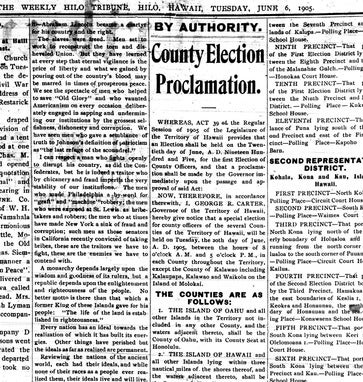
In 1905 the Territorial government passed Act 39, providing for the creation of counties in the Territory of Hawaiʻi. County governments across Hawaiʻi are still based on the system created in 1905. The election of June 20, 1905, heralded in Hawaiʻi County’s first Sheriff William M. Keolanui. Nine deputy sheriffs were also elected, four in east Hawaiʻi: William Fetter, James Mattoon, W.J. Rickard, and S.H. Kaaheo; and five in West Hawaiʻi: David Baker, J. W. Kaliikoa, J.K. Kakaula, W.M.S. Lindsey, and C.H. Pulaa.
First Car Registered in Hawaiʻi County
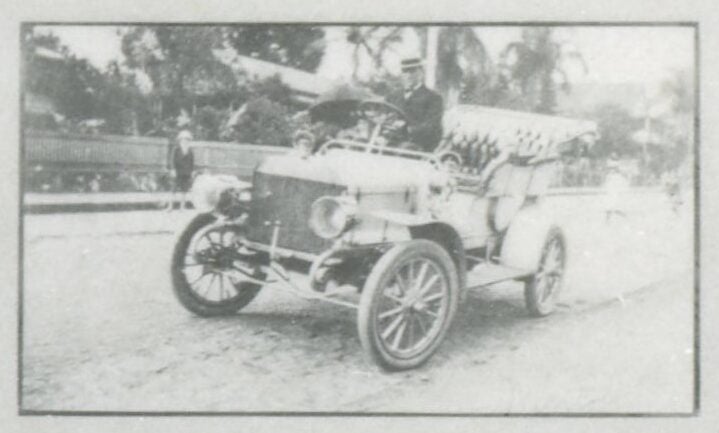
A year after Hawaiʻi County was officially established in 1905 and elected its first Sheriff, the first vehicle was registered on island. At the time, vehicles were still a novelty in Hawaiʻi with the majority of people and goods traveling by horse-powered transportation. Indeed, the first automobile arrived in Hawaiʻi in 1899, just three years after making its debut on the mainland.
However, with the automobile’s new technology allowing for faster movement, came the County’s first speeding ordinance in August 1906. Section 13 of the speeding ordinance called for a speed limit of 8 mph within Hilo town limits. Beyond Hilo town limits, the speed limit was 15 mph, although drivers had to reduce their speed to 4 mph when coming to a road crossing, going down a steep hill or curve, or making a turn. There were additional rules for signaling and stopping so as to not spook horses and other draft animals.
The fines for not obeying the speed limit or stopping at an intersection for horses were significant. First offense traffic citations were $25, a second citation would set you back $50, and an astronomical $250 for a third offense. To put the cost of the traffic tickets in perspective, in 1905 Hawaiʻi five pounds of flour cost 16 cents, a gallon of gasoline cost 21 cents, and one ton (2,000 pounds) of coal cost $11.
Pictured is a photo of the very first vehicle registered in Hawaiʻi County in 1906.
Hawaiʻi Police Department Pistol Team
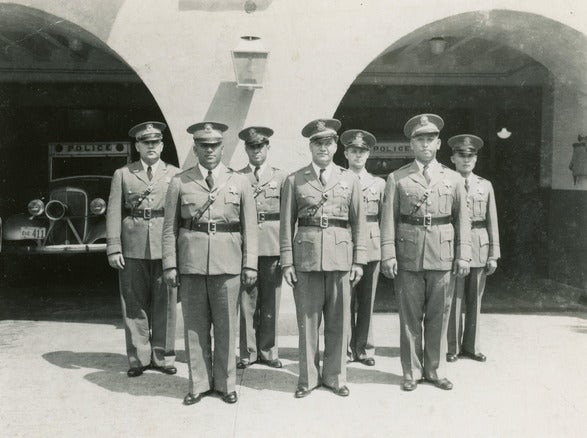
Pictured is the 1938 Hawaiʻi Police Department Pistol Team. Front row: Lt. Charles Warren, Lt. James Martin, Walter Victor, Back row: George Martin, Andrew Cummings, Martin Palmer, and Shigeharu Miyada.
First Chief of Police, George Larsen Jr.
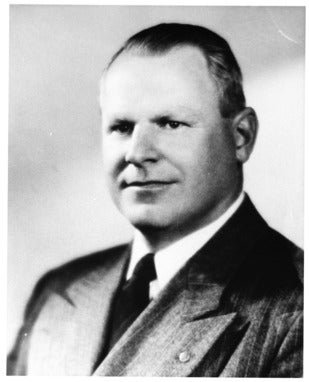
In 1943, Hawaiʻi Police Department as we know it was created when the Hawaiʻi Territorial legislature passed Act 62, abolishing the position of sheriff and placing the department under the authority of the Hawaiʻi County Police Commission, effective July 1, 1943.
At the time, members of the Police Commission were appointed by the governor, Ingram Stainback, who had been appointed Governor by President Franklin D. Roosevelt in Aug. 1942. The Police Commission appointed the Police Chief, who in turn appointed an Assistant Chief with the approval of the Commission, much as it is today.
In the first half of 1943, the department had two Chief Deputy Sheriffs, one for East Hawaiʻi and one for West Hawaiʻi (similar to today’s Assistant Chiefs in Area I (east side) and Area II (west side.) There were eight Deputy Sheriffs, one to command each of the department’s eight districts, the equivalent of our current District Captains.
On June 30, 1943, there were a total of 157 personnel in the department, 103 regular employees and 54 OCD Auxiliary Police (members of the Office of Civilian Defense.)
The Police Commission appointed the first Chief of Police, George Larsen Jr., who had been Chief of Maui Police Department Junior Police Officer (JPO) program. Chief Larsen started on July 1, 1943, ushering in the current history of Hawaiʻi Police Department.
Junior Police Officer (JPO) Program
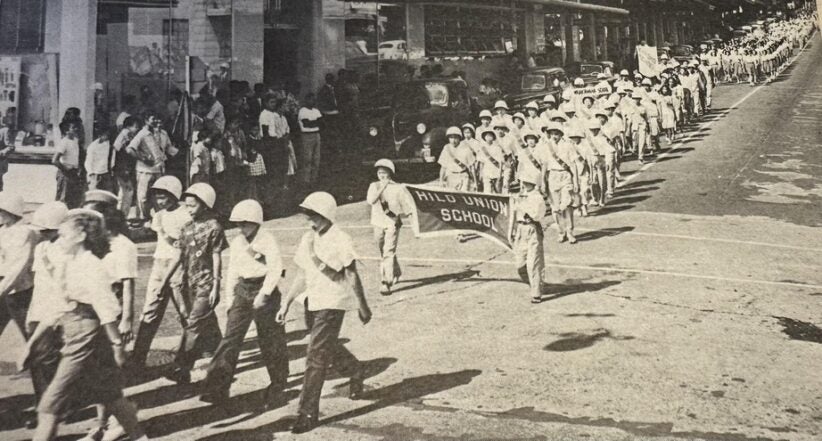
In the 1940s, Hawaiʻi Police Department launched a Junior Police Officer (JPO) program, in which school-age children volunteered to serve as traffic crossing guards at various schools around the island.
The student JPOs were considered an adjunct to the department. They started their school day before anyone else and finished after everyone else had gone home, often standing in the pouring rain directing traffic, thereby helping fellow students get to and from school safely.
Although it is unclear what year the program started, the Department’s 1947 annual report mentions that there were 1,029 JPOs. By the following year, that number had grown to 1,200 Junior Police Officers.
To recognize the efforts of these student volunteers, the Department solicited donations from various businesses and civic groups and held a jamboree in Hilo every year for the JPOs. A parade through Hilo town was held followed by field events and a luncheon. Junior Police Officers were also granted the privilege of attending a weekly movie without charge at theaters across the island owned by Senator W.H. “Doc” Hill.
Pictured is a 1948 Junior Police Officer parade in downtown Hilo.
The Establishment of the Traffic Safety Bureau
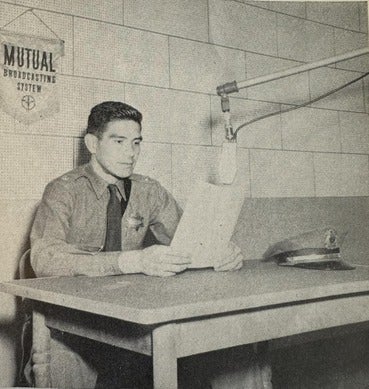
Hawaiʻi Police Department’s Traffic Safety Bureau, what we know today as the Traffic Enforcement Unit, was first established on June 1, 1949. A “new super-highway” (Highway 11) along the Hāmākua coast and through the Volcano area made it imperative to conduct traffic enforcement in these areas in order to reduce reckless driving.
The Traffic Safety Bureau also prepared radio and newspaper messages about all things related to traffic safety. Pictured is Lieutenant William Kamau, head of the Traffic Enforcement Unit, at the microphone during one of his weekly “Safety” broadcasts.
Completion of Hale Nani Police Academy and Firing Range
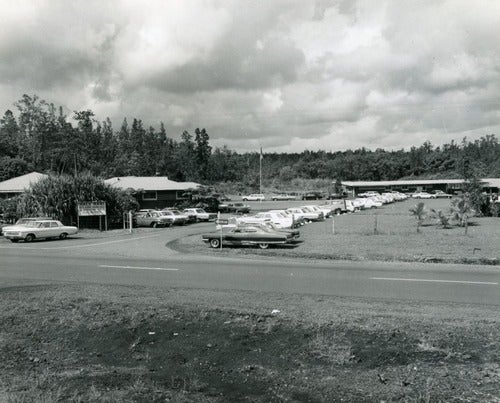
Mid-July 1954 saw the completion of Hale Nani (beautiful home), Hawaiʻi Police Department’s new training academy, firearms range, and recreational center. The firearms range included 51 swivel targets for timed and rapid fire.
The facility became the site for departmental, multi-agency, and juvenile firearms trainings, firearms competitions, and even the department’s annual Christmas party.
Department-wide Reorganization
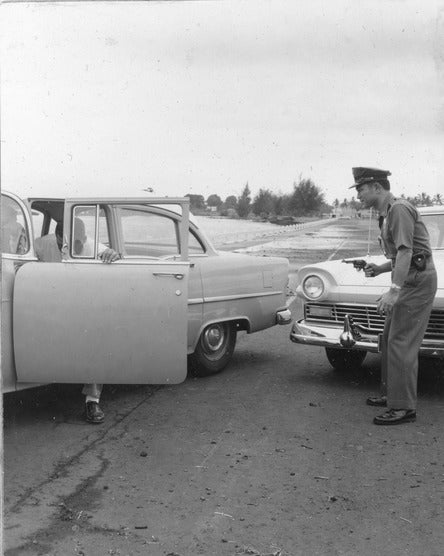
From 1950-1958, the workload of HPD increased by 350%, yet during the same time, the number of personnel had only increased by one-third.
After studying other police departments around the county, Chief Anthony Paul, streamlined the department, redefining the supervisory levels within the department and overhauling the organization of the department. The department was divided into four divisions, including:
Operations: covering all patrol districts, detectives, prison personnel, juvenile officers and radio technicians.
Administrative: handling record keeping, fingerprinting, recruit and in-service training, operational procedures, budgeting, accounting, and purchasing.
Traffic and Special Services: responsible for traffic safety, Junior Pedestrian Officers, issuing motor vehicle licenses and drivers licenses, studying traffic conditions, and managing the civil defense units.
Public Services: responsible for public relations, public attitude surveys, and information for press, radio, and news programs.
Pictured is a photo from the 1956 annual report showing an officer apprehending the suspect of a stolen vehicle.
Radiological Training Class at Hale Nani
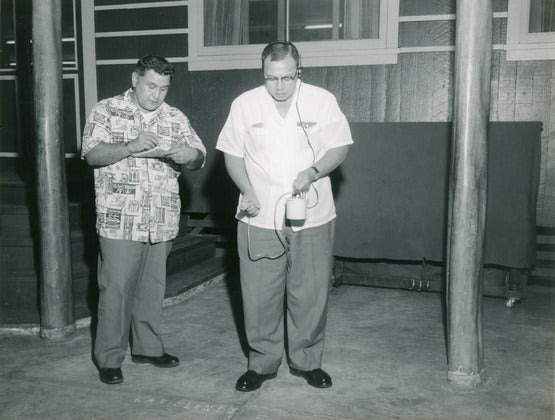
From its earliest decades, Hawaiʻi Police Department has conducted a wide range of training to prepare officers to handle a multitude of threats, including radiological threats.
Pictured is a 1961 radiological training class at the Hale Nani training facility.
Even as threats and society change, HPD maintains its preparedness and still conducts radiological training to this day.
24-hour Police Coverage Begins
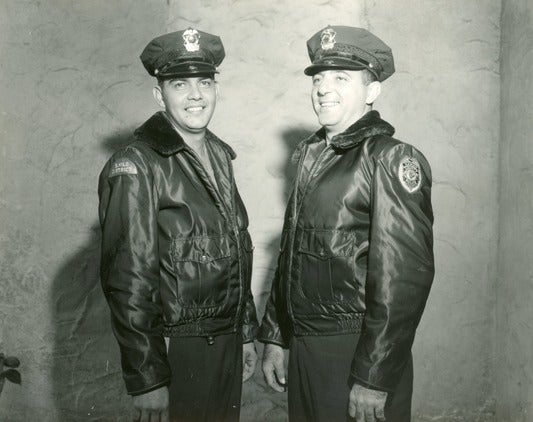
In 1965, the Hawaiʻi County Board of Supervisors approved the creation of 12 new police officer positions, bringing the total number of personnel to 160 to serve a population of more than 60,000 residents. The increase in manpower made it possible for the creation of the first-ever overnight shift (11:30 p.m. to 7:30 a.m.) in Kona, starting on December 16, 1965.
This was a historic occasion because it marked the first time that 24-hour police coverage was available on island outside of Hilo. At the time, it was noted that Kona was experiencing rapid development and was growing dramatically as a tourist destination area. Additional personnel were added to the South Kohala, Kaʻū, Puna, and Hilo districts as well.
Pictured are two police officers from 1965 wearing the official police department jacket and uniform, which used to be brown.
The Creation of the Captain Cook Station
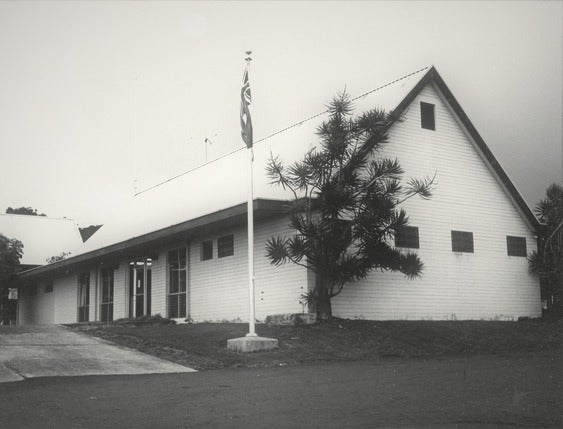
The Hawaiʻi Police Department saw the addition of two new police stations in 1966, one in Keaʻau and one in Captain Cook, referred to as the Kona station. Back then, there were no police stations in Pāhoa or Kealakehe, and these were the two stations for the Puna and Kona districts.
For Kona, the new station along Māmalahoa Highway in Captain Cook came just in time, as 1966 was also the first full year of 24-hour police coverage in that district. Almost 18% of all police services in Kona that year were handled by officers working first watch (overnight shift) from 11 p.m. to 7 a.m.
First Female Police Woman
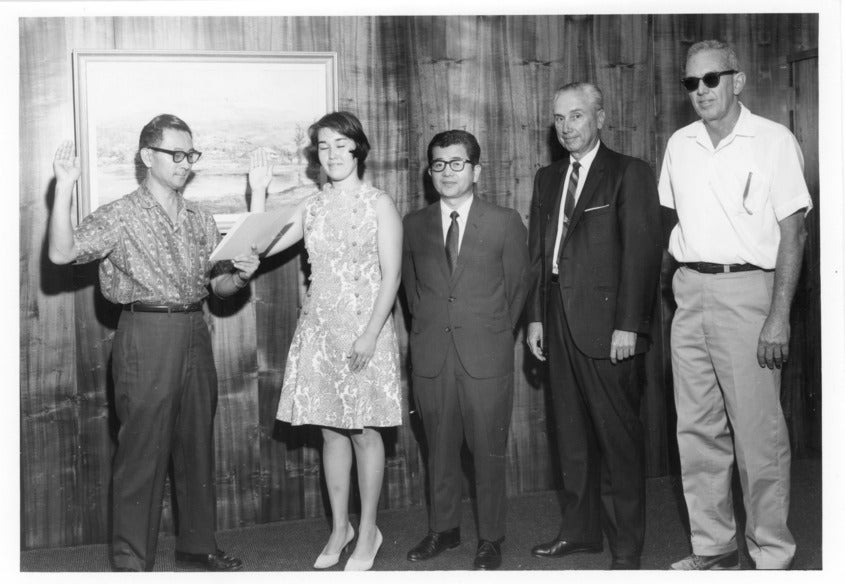
Hawaiʻi Police Department achieved a major milestone in February 1968 when Mrs. Cheryl Reis was sworn-in as the first policewoman in the department’s history. It’s worth pointing out that she was not referred to as a female police officer, but rather a police woman. In fact, Policewoman Reis was not assigned a police uniform like her male counterparts and instead was assigned to wear a dress and heels.
Assigned to the Juvenile Bureau, Policewoman Reis recounted having to chase suspects and runaways over lava rock walls while wearing heels. During her 26-year tenure, policewoman Reis had a distinguished career, becoming the first female Sergeant, Lieutenant, Captain, and, in 1991, the first female police Major in the department’s history. She retired in 1994. Pictured is the swearing in of Policewoman Reis in Feb. 1968. You can watch a video of Retired Major Reiss talking about her career on our YouTube channel.
That same year, in September 1968, ground was broken for a new police station in Honokaʻa for the Hāmākua district, and plans for a new County Jail in Panaʻewa were completed. The Hawaiʻi County Police Commission, recognizing that the department’s main station in Hilo, located at 141 Kalākaua Ave., was too small and in poor condition, started exploring plans to build a new police headquarters in Hilo.
Community Relations Outreach Programs
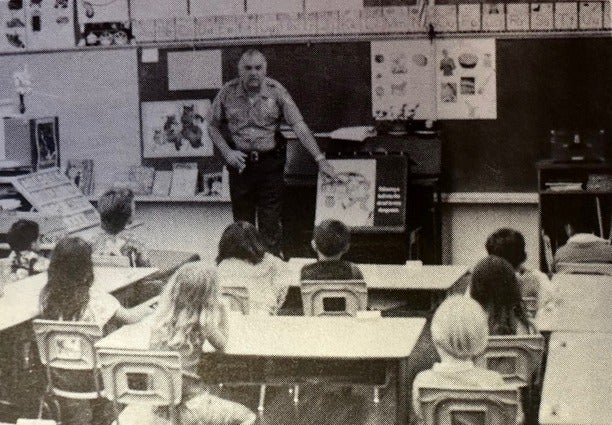
In the early 1970s Hawaiʻi Police Department offered a variety of Community Relations programs that focused on encouraging different types of safety with island keiki.
“Pals on Wheels”, a program to acquaint youngsters with the motorized officer, (as opposed to foot patrol officers) was launched in 1973. The program involved officers visiting elementary schools with a patrol car, exhibiting and demonstrating some of the equipment used by a patrolman in his work.
“Officer Bill”, played by Sergeant Gerry Meyer and Officer Delbert Araujo, were sought-after speakers, talking to more than 6,700 grade school children in 1973 alone.
Today, our Community Relations Section continues to conduct outreach with schools and community groups across the island.
Pictured is Officer Bill talking to a classroom of school kids about the dangers of dashing across the street.
New Police Cars
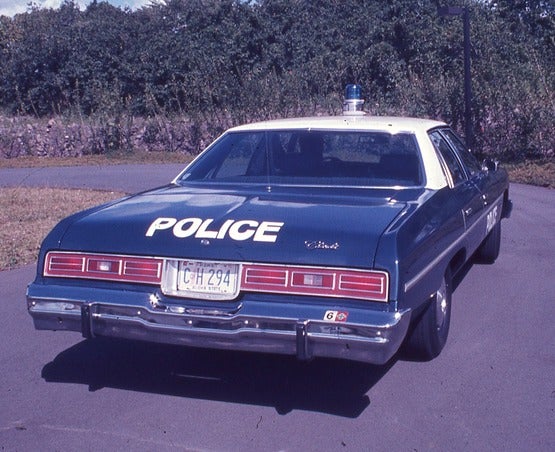
A lot of exciting improvements happened at Hawaiʻi Police Department in the mid-1970s. A new island-wide microwave radio hookup, designed to allow better communication between districts was implemented in 1976, as was the use of blue dome lights for all patrol cars.
Operated from within the vehicle, the blue lights were designed to provide greater visibility and had a pilot light for night use to identify the vehicle as a police car on patrol. The lights were attached to a strap, and could be easily removed by the officer when off duty.
And on the subject of police cars, in August 1976, HPD initiated a seven-car County police fleet in Puna, to test the feasibility of a fleet operation. Puna officers drove the four-door specially equipped cars while on duty.
Current Headquarters Completed
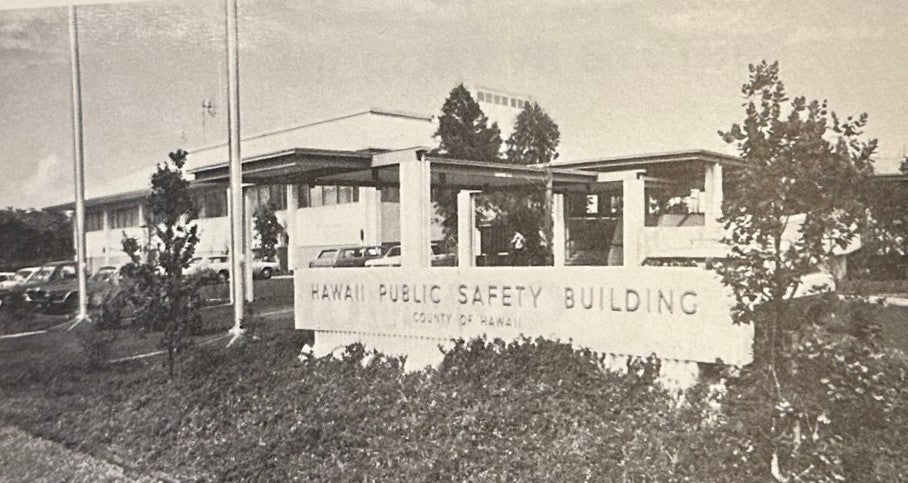
Hawaiʻi Police Department achieved a new milestone in October 1975 when it moved its headquarters from the old cramped building on Kalākaua Avenue into new spacious facilities at 349 Kapiʻolani Street.
The three-phase complex, which was designed by Oʻahu-based architectural firm Richard Matsunaga and Associates, started with a site selection study back in 1967 and would take til the end of the 1970s to be completely built out.
Constructed by Kitano-Oda Constructors Ltd. on land purchased by the County from the Richardson Estate, the phase one building took 19 months to complete at a cost of $2.5 million.
To this day, the building still contains all the administrative offices of the department, as well as dispatch operations. The initial plans called for HPD’s training facilities to be housed on the first floor of headquarters. While the second phase building, designed to house the operational units, was being built, operations was located on the first floor and when the second phase building was completed in 1979, the training section moved into the first floor as originally planned.
According to HPD’s 1976 Annual Report, the phase three building was initially slated to house Civil Defense, the Department of Liquor Control, and headquarters for Hawaiʻi Fire Department.
Pictured is the new police headquarters as it looked when completed in 1976.
First Female Patrol Officer
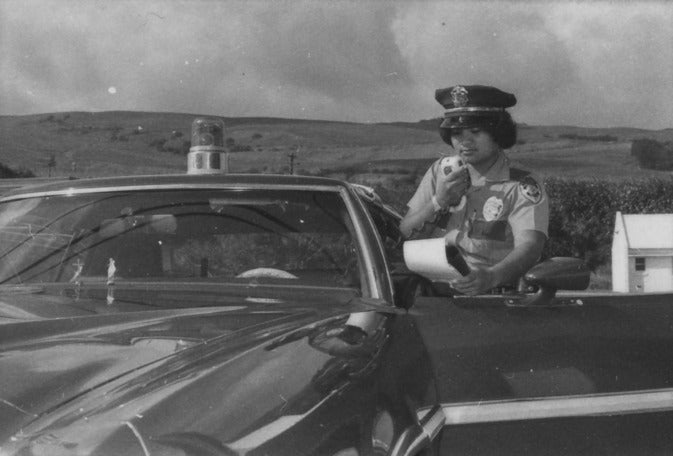
When Officer Ann Gamayo joined the department on October 1, 1975, a month shy of her 22nd birthday, she was HPD’s first female patrol officer.
Gamayo, who later married and became known as Ann Mejia, had wanted to be a police officer from her youngest days, but back then her elementary school teachers laughed at her. Officer Mejia proved them wrong and went on to have a successful career spanning more than three decades at Hawaiʻi Police Department, retiring as a Detective in 2006. The first few years of her career, Officer Mejia was assigned to solo patrol duty in the rural Kaʻū district (pictured), where she worked for three years.
First Four-wheel Drive Patrol Vehicles
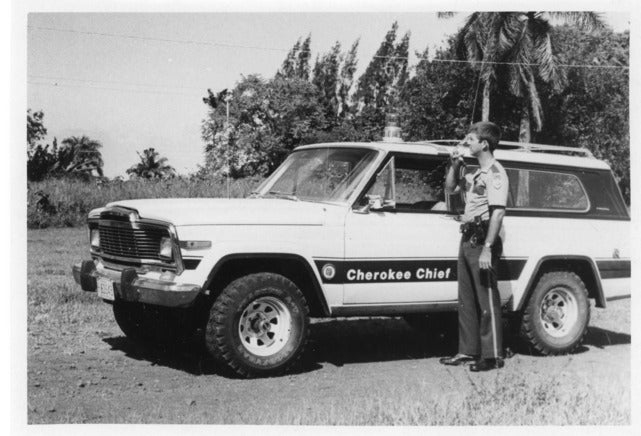
Hawaiʻi Police Department patrol officers started using four-wheel-drive vehicles for the first time in 1978. Given that Hawaiʻi Island is twice the size of all the other major Hawaiian islands combined, these new vehicles enabled officers to better be able to help people, and to respond to calls, through the use of the four-wheel-drive vehicles.
Crime Lab Created
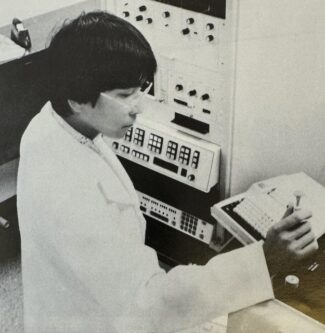
As the 1970s came to a close, Hawaiʻi Police Department took a big step forward in its fight against crime, when the department’s Crime Lab went from becoming a dream to a reality with the purchase of an array of highly sophisticated equipment.
Using funds from the Federal Economic Development Agency and the Law Enforcement Assistance Administration, the department was able to obtain a gas chromatograph, a second gas chromatograph tied to a mass spectrometer, an ultra violet spectrophotometer, a stereo microscope, a photo microscope, comparison microscopes, and dissecting microscopes.
The chromatographs and the spectrophotometers are used primarily to identify compounds to determine if substances are drugs, poisons, pesticides, or other matter. The other equipment in the Crime Lab can be used for fiber comparisons, firearm identification, blood analysis, paint comparisons, and more.
Prior to the department purchasing this equipment, which cost more than a quarter of a million dollars in 1979 and 1980, only Honolulu Police Department, the FBI, and the Drug Enforcement Agency, had similarly advanced equipment. Hawaiʻi Police Department had to send away items of evidence, which took weeks if not longer, often delaying cases.
Pictured is Criminalist Kenneth Saito in 1979 using some of the new Crime Lab equipment. Saito handled most of the internal lab work and also taught classes to HPD officers in the proper handling of evidence, analysis, and related subjects.
First Police K9s
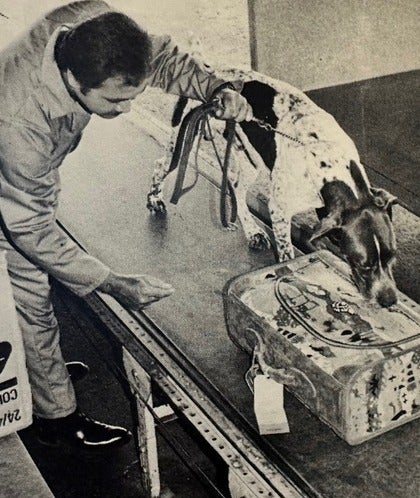
In July 1982, Hawaiʻi Police Department started the process of adding police dogs as a valuable asset in the war against drugs. Two officers with an affinity for dogs, James Ferry of Hilo and Thomas Hickox of Kona, were designated as dog handlers and sent to Oʻahu to learn the art of handling and training narcotics canines. Two dogs, a German short-hair pointer and a black Labrador were donated to the department by private citizens.
The two officers underwent 200 hours of training with the two canines undergoing two months of rigorous training. This was followed by a final certification process that included a five-day testing period in which each dog was required to sniff out and locate a total of 136 hidden drug packets.
Both dogs were certified in early 1983. In their first four months of active use, they were responsible for the execution of a dozen search warrants and the recovery of illegal drugs.
Pictured is Officer Thomas Hickcox with his K9 partner, a German short-hair pointer, examining a suitcase in 1983.
Kona Police Station Completed
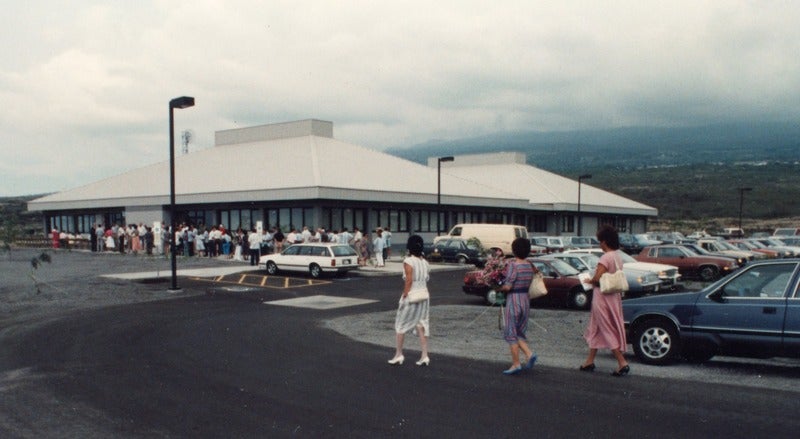
As tourism increased in the 1960s, 70s, and 80s, so too did the population of the Kona district and it became apparent to all that an additional police facility was needed to better serve the growing west-side communities.
On October 26, 1988, local officials and residents were invited to attend the grand opening ceremony of the long-awaited Kona Police Headquarters at Kealakehe and tour the facilities. The 21,000-square-foot complex was constructed on a 10-acre parcel of state land about a half-mile from Kailua town and cost $3.3 million in 1988. The new facility was the result of nearly two decades of hard work by many in the Kona community, including business leaders, the county council, and the Hawaiʻi County administration.
911 System Launched
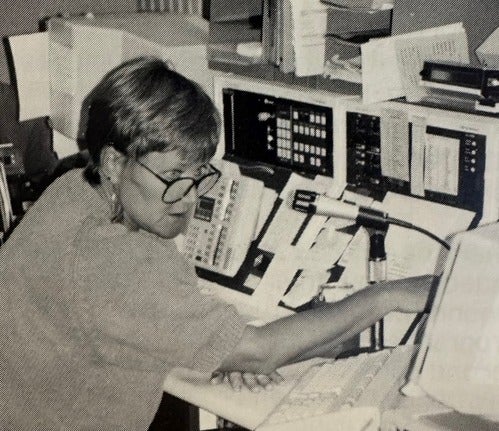
On September 11, 1992, dialing 9-1-1 for emergency police, fire, and ambulance services was launched in Hawaiʻi County. Prior to that, only South Hilo and Kona stations dispatched police units 24 hours a day. With the implementation of the new 9-1-1 system, Central Dispatch could now handle calls island-wide from police headquarters in south Hilo. As a result, Hawaiʻi Police Department’s Communications Section grew considerably from a staff of 11 in 1990 to 29 dispatchers in 1993.
During its first year of use, the new 9-1-1 call system received a monthly average of more than 5,300 telephone calls.
Pictured is Police Radio Dispatcher Sharon Kennelly in 1992 assigning police patrol units to a reported disturbance call in Honokaʻa.
New Kaʻū Station Completed
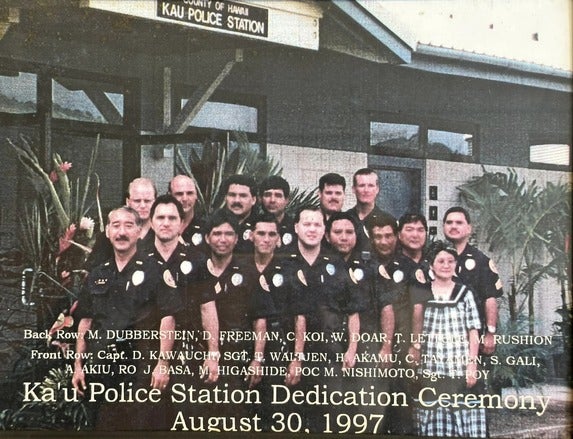
Covering more than 900 square miles, Kaʻū is one of the largest and most rural police districts on island. At one point, police used a residential home in Nā‘ālehu as the site of the Kaʻū police station and operated substations in Pāhala and the Hawaiian Ocean View Estates (HOVE) subdivision.
On September 12, 1996, a ground-breaking ceremony was held for a new Kaʻū police station at Kaunamano. At the time, Kaʻū had roughly 4,500 residents served by 12 police officers, two sergeants, and a captain. On August 30, 1997, a grand opening ceremony was held at the new station with Kaʻū District Captain David Kawauchi serving as the master of ceremony.
Police Chaplains
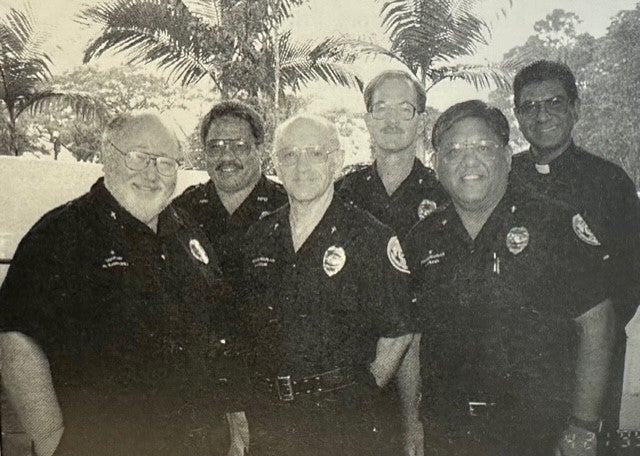
Police chaplains are a small, dedicated group of volunteers who assist police officers and their families, along with members of the community, with counseling, making hospital and sick calls, handling funerals, weddings, and giving invocations and benedictions at various police functions. Sometimes it’s as simple as delivering a cup of coffee on a cold night when officers are involved in an hours-long incident. Other times it means responding in the middle of the night to a gruesome car wreck.
Hawaiʻi Police Department’s Police Chaplain program started around 1989-1990 when five chaplains of various faiths received their oaths of office. At the time, each chaplain volunteered around 40 hours a month.
By 1998 there were eight police chaplains who volunteered more than 1,000 hours during the 1998-1999 fiscal year. Police chaplains are a valued and respected part of the Hawaiʻi Police Department ohana and the men and women of HPD are grateful for the services they provide!
Pictured are six police chaplains from the 1998-1999 annual report from left: Henry Kahalehili, South Hilo; Sonny Shimaoka, Kona; Duane Slocum, Puna; Ted Lesnett, Hāmākua and North Hilo; Al Soliven, South Hilo; and Ezekiel Jittu, North and South Kohala. Two of the chaplains, Jim Ferry of Kona and Harold Teves of Kaʻū, are not shown.
Learn more about the department’s Police Chaplain program in this May 2023 interview with Police Chaplain Coordinator Pastor Renee Godoy.
Police Memorial Wall Unveiled
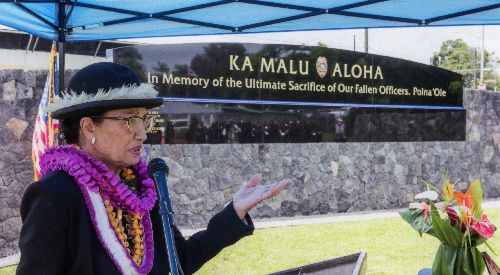
In 2016, Hawaiʻi Police Department’s Memorial Wall, located adjacent to the Hilo Police Station, was unveiled during the annual Police Week ceremony. The majestic memorial, which resembles a large hug with its long, curved sides, is all the more remarkable given the 26-year journey undertaken by the sister of one of our fallen officers to see the wall created. Were it not for Momi Cazimero’s tenacious dedication, our Police Memorial Wall would not exist today.
Our island community owes a debt that can never be repaid to the Jitchaku family and the families of the other fallen officers who have made the ultimate sacrifice safeguarding our community. We are deeply grateful and appreciative of Momi for her decades-long efforts to see our Police Memorial Wall built. Learn more about our Police Memorial Wall and the history behind it.
Unsolved Homicides
Hawaiʻi Police Department believes every victim deserves justice, and that the deceased victim’s family, friends, and community deserve closure.
Please take a moment to review the Unsolved Homicides summaries and if you have any information pertaining to any of these cases, please submit a tip, email us or call our Unsolved Homicides Division at (808) 961-2380 or Crime Stoppers at (808) 961-8300. Thank you for your help!
